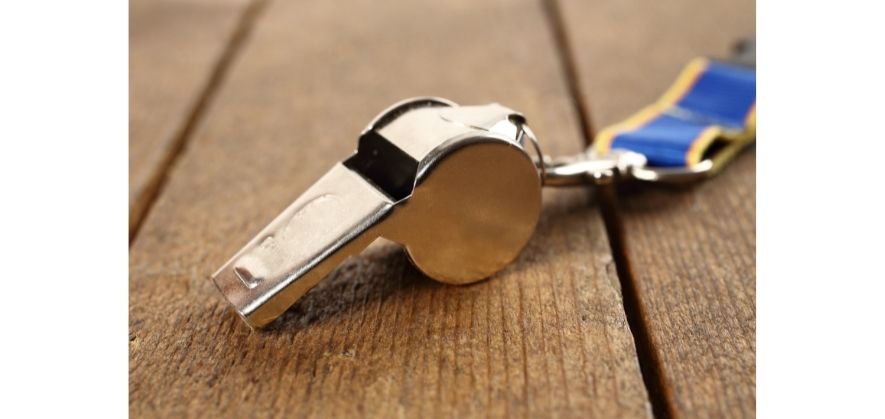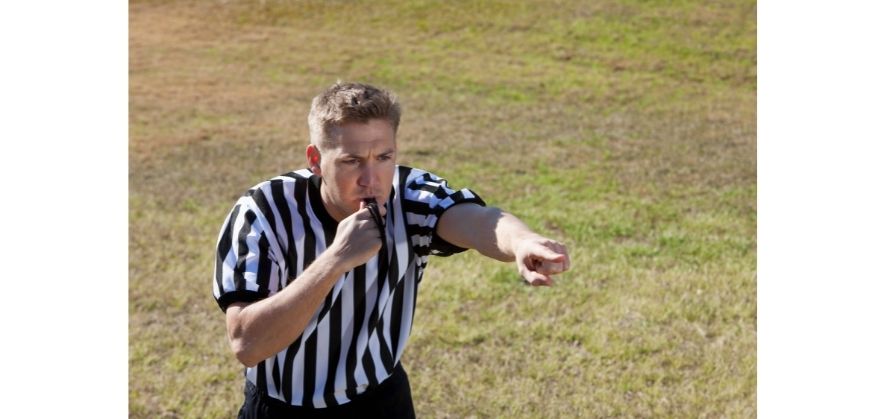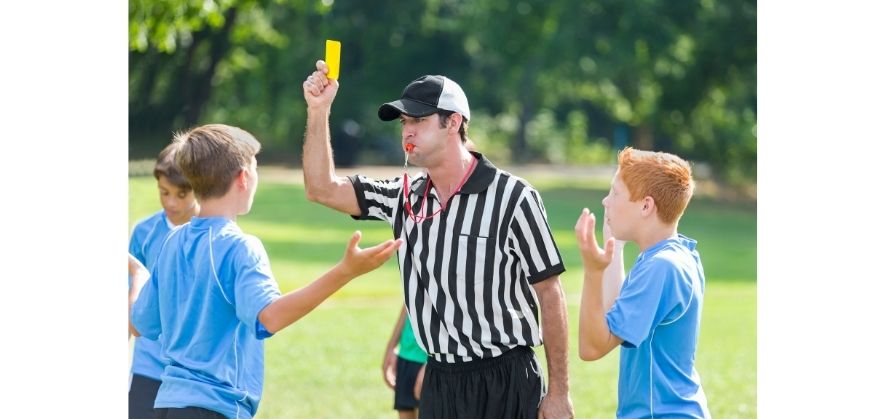Disclaimer: Soccer Whizz is a participant in the Amazon Services LLC Associates Program, an affiliate advertising program designed to provide a means for sites to earn advertising fees by advertising and linking to Amazon.co.uk (source: Section 5). As an Amazon Associate I earn from qualifying purchases.
Soccer referees make tough decisions out on the pitch.
With a single blow into their whistles, they play a significant role in dictating the flow of the game and making sure that its participants maintain discipline as they compete by adhering to all the rules and regulations.
Now, this article isn’t going to talk about the history of referees or discuss how difficult their on-field jobs are.
Instead, it shall specifically focus on answering the question of why referees carry two whistles with them to officiate matches.
As is tradition on the Soccer Whizz blog, we shall begin with a succinct summary…
Soccer referees carry two whistles for the main reason of having one whistle as a backup option in case anything were to happen to the primary whistle during a game. This could include damage to the whistle which makes it malfunction, or even misplacement as a result of the object falling onto the grass.
But the reasons don’t stop there!
Read on to learn more about why referees carry more than one with them.
Reasons why soccer refs have two whistles
Admittedly, it doesn’t sound immediately obvious to a reader why a referee would decide to carry two whistles to a game.
This is especially because there’s a really slim likelihood of an event unfolding that prevents the match official from blowing into their “trusted trumpet”.
But stranger things have happened in soccer, which is why referees like to carry what is called…
1. A backup option

Referees always need to be prepared.
Because sometimes when they step out onto that pitch and begin officiating, things can go wrong.
For example, if a referee was running at pace to keep up with a counter-attacking play with their whistle in hand, the object could fall onto the ground right when they’re in full stride (i.e. arms swinging backward and forward).
Once that whistle drops on to the turf, it can be pretty difficult to find.
The search for it would be even more difficult if the grass was long and hadn’t been cut in a long time.
In such a scenario, the game would have to be temporarily halted whilst the referee tried to located their whistle.
And that wouldn’t be ideal for the spectacle or the competitive aspect of it either.
The attacking side would be frustrated at the loss of their offensive momentum, brought about by a referee simply not being careful enough to cling on to their whistle as they ran on the field.
So, having a backup whistle becomes very important.
Without one, referees wouldn’t be able to start, stop and resume play.
Even if the referee lost their original blowing device, they could easily resort to making use of the backup whilst they searched for the misplaced one.
Doing so wouldn’t cause much if any disruption to the match.
In other cases, a backup could be needed in case the original whistle malfunctioned in any way.
For example, this could be as a result of prior damage – like a crack to the blowing mechanism of the object – that wasn’t inspected before the game commenced.
Having a secondary whistle in this case also allows the referee to get on with the game and worry about fixing the original or finding a replacement after the match has concluded.
2. Varying tone of sound

If you’ve officiated a number of matches as a referee, then this reason should make a lot of logical sense to you.
Anyway, for those who haven’t a clue what this could be about, just keep on reading.
In higher level games, referees could use each whistle to signify a different sort of foul or infringement that’s been committed by a player.
For instance, one whistle could be blown when common fouls like trips, pushes, shoves or rash tackles are made, whilst the other could be used for more intense signaling like when a mass confrontation or a full-blown brawl between two sets of players is about to ensue.
When used in this way, referees can actually enhance their on-field presence as players can be able to differentiate between the moments when a “light” foul has been made as opposed to a more “severe” foul requiring greater disciplinary action.
In addition, some referees simply split the use of the whistle between cautionary fouls where a lecturing or yellow card needs to be brandished, and the more dangerous incidents that require sending a player off of the field via a red card signal.
3. Avoiding player confusion

Lastly, referees can use two whistles in the unlikely event that another soccer match is taking place on a field adjacent to the one they are already on.
If the referee on the opposite field had the same brand of whistle that you did, then it would be quite difficult to discern where and when the fouls or infringements are being called.
Because the whistle on the other pitch sounds the same, players wouldn’t be able to distinguish between when their match and the play on the other field is being stopped.
That would then result in lots of confusion.
So, to combat this possibility, referees come armed with two whistles to games, with the backup option preferably being of a different brand and tone to the original just in case the official on the other end had an exact replica.
Confusion can diminish the entertainment value of soccer as a spectacle, and it’s also a reason why referees wear different jersey colors as they need to stand out from both sets of players.
What whistles do FIFA referees use?
There doesn’t seem to be any sort of official documentation governing the sort of referee whistle that match officials should use.
Obviously however, quality is important when it comes to the products that referees use, so they need to ensure that the items they carry with them on to the pitch are reliable, effective and efficient.
According to this e-commerce store, the Molten Valkeen whistle below was used at the 2014 FIFA World Cup in Brazil, which probably means that it’s a relatively good model:
- Great for soccer and football coaches and referees
- Clear-cut, high-pitched tone carries over long distances
- Flip Grip mechanism allows access while on the move
You can also scroll down to see some alternative referee whistles that we recommend:
- Fox 40 Classic Finger-grip Whistle
- Color: black
- Sound Power: 115 dB
- 4 sound-producing resonators built into 2 chambers.
- Extremely easy to blow, cannot be overblown.
- Flawless patented pealess whistle emits sound power of +120dB.
- Waterproof speed pea works in rain
- Easy blow with instant response
- Tests confirm that the Thunderer outperforms the closest of competitors
- Patented 4 octave sound
- Constant clear tone
- 2 frequency ranges (3.74 and 4.10 kHz)
- SPORT WHISTLE: Make the right call with a sport whistle from Crown Sporting Goods!
- LOUD AND CLEAR: Features a bold, crisp sound that requires less breath than traditional pealess whistles
- JUST THE RIGHT LENGTH: Adjust the gold bead to control the length of the lanyard. Find the most comfortable setting and lock it in
Final thoughts
And that’s a wrap!
You should now thoroughly understand why professional referees typically carry two whistles to matches.
If you’ve enjoyed reading this article, you should also have a look at some of our other referee-related posts like:
- Whether soccer referees can change their decisions;
- Whether soccer referees are allowed to wear hats;
- How many referees there are in a soccer game;
- Why referees wear two watches when officiating; and
- The best referee watches you can wear
If you enjoy the content that I create and would like to buy me a coffee, then I’d really appreciate it!
Any money that I earn through this donation will be re-invested into more content for this website.
Additionally, by sending in a donation you’ll also receive a copy of my recently released 190+ page eBook on Soccer Ball Care, as well as be subscribed to our mailing list where you’ll be regularly informed on the latest developments concerning the Soccer Whizz blog.
- Future Icons: Europe’s Emerging Midfield Maestros Set for Glory - December 4, 2023
- Kickstarting a Revolution: How Soccer Transformed the United States Over the Last Four Years - October 7, 2023
- 4-1-4-1 Soccer Formation [Analysis] - September 23, 2023







